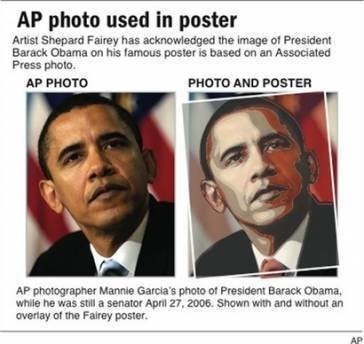
The AP shot back at Shepard Fairey yesterday, filing counterclaims alleging that Fairey's HOPE poster, which he created based on a photograph by Mannie Garcia, was a "willful and blatant violation of the The AP's copyright." Despite its melodramatic rhetoric, the AP has a weak case.
The AP first publicly accused Fairey of copyright infringement in early February, but didn't file a lawsuit in the hope, it said, of an amicable solution. Instead, the AP's lawers reached out to Fairey and, according to the AP's countersuit, "made every effort amicably to enter into a license and avoid litigation." But in a strategic move the AP calls bad faith, Fairey sued first, asking a court to declare that he had not infringed the AP's copyright.
As I argued just before he filed his lawsuit, Fairey's use of the Garcia photograph almost certainly qualifies as "fair use" and therefore does not amount to copyright infringment. And that, of course, is the real issue. The AP spends a lot of time in its complaint attacking Fairey for making artwork in the past that supposedly violated other people's copyrights, and for "hypocritically" suing people he claimed violated his copyright, but these assertions are as legally irrelevant as the AP's statement that "more than 30 AP journalists have lost their lives in the line of duty."
There is another real issue, one that technically comes before the question of fair use: whether the AP owns the copyright to Garcia's photograph in the first place. The AP claims in its countersuit that it hired Garcia as "a full-time salaried staff photographer," implying that the AP owns the copyright to Garcia's work as an employee. But when I spoke to Garcia in early February, he told me in no uncertain terms that he had worked for the AP as a freelancer, not a full-time employee, and that it was only after the AP learned that the Fairey poster was based on his photograph that the AP started telling Garcia he'd been hired as an employee. In fact, (as he had told others) Garcia said that the only contract he signed with the AP was one for an "independent freelance writer" that doesn't even mention photographs---which, if true, makes the AP's copyright-ownership claim all the more dubious.
Figuring out what is and isn't true is the next step in the lawsuit, as the parties enter "discovery" and each side investigates the other side's evidence.
There is a lot at stake here. As Law Professor Bruce E. Boyden explains in a detailed examination of the AP's counterclaims, the "AP is casting a broad net over all appropriation art." An AP victory in this case would undermine artistic freedom. And it would, to paraphrase Professor Lawrence Lessig from his recent presentation at the New York Public Library, effectively outlaw a legitimate form of art.
The AP cloaks itself in the noble vocabulary of freedom, proclaiming that its "news gathering activities require it, often at great expense, to remain a strong advocate of the First Amendment." But the "fair use" doctrine is what keeps copyright law from violating the First Amendment. If the AP were really advocating for free speech, it wouldn't have filed its counterclaim.
Jonathan Melber is an attorney and co-author, with Heather Darcy Bhandari, of ART/WORK: Everything You Need to Know (And Do) As You Pursue Your Art Career (Free Press), a professional-development guide for visual artists. He and Heather twitter here.